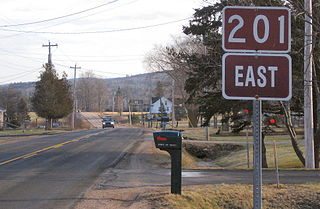
The Gulf of St. Lawrence is the outlet of the North American Great Lakes via the St. Lawrence River into the Atlantic Ocean. The gulf is a semi-enclosed sea, covering an area of about 226,000 square kilometres (87,000 sq mi) and containing about 34,500 cubic kilometres (8,300 cu mi) of water, at an average depth of 152 metres (500 ft).

Digby is an incorporated town in southwestern Nova Scotia, Canada. It is in the historical county of Digby and a separate municipality from the Municipality of the District of Digby. The town is situated on the western shore of the Annapolis Basin near the entrance to the Digby Gut, which connects the basin to the Bay of Fundy.
Beaubassin was an important Acadian village and trading centre on the Isthmus of Chignecto in what is now Nova Scotia, Canada. The area was a significant place in the geopolitical struggle between the British and French empires. It was established in the 1670s on an upland close to an extensive area of saltwater marsh. Settlers reclaimed the land to engage in cattle ranching and trade.

Province House in Halifax is where the Nova Scotia legislative assembly, known officially as the Nova Scotia House of Assembly, has met every year since 1819, making it the longest serving legislative building in Canada. The building is Canada's oldest house of government. Standing three storeys tall, the structure is considered one of the finest examples of Palladian architecture in North America.

Fort Anne is a four-bastion fort built to protect the harbour of Annapolis Royal, Nova Scotia. The fort repelled all French attacks during the early stages of King George's War.
Granville Centre is a rural Canadian community located in Annapolis County on the north shore of the Annapolis River in western Nova Scotia. The community is named after John Carteret, 2nd Earl Granville.

District of Shelburne, officially named the Municipality of the District of Shelburne, is a district municipality comprising the eastern section of Shelburne County, Nova Scotia, Canada, but does not include the Towns of Shelburne or Lockeport. Statistics Canada classifies the district municipality as a municipal district. It is home to the Bowers Meadows Wilderness Area.

Clark's Harbour is a town on Cape Sable Island in southwestern Nova Scotia, Canada, located in the Municipality of the District of Barrington in Shelburne County. The main industry is lobster fishing. Owing to this as well as the town's history as a fishing community, the town is noted as the birthplace of the Cape Islander fishing boat.

Route 201 is a collector road in the Canadian province of Nova Scotia.
Cornwallis Park is a rural community in Annapolis County, Nova Scotia, Canada. As of the 2021 census, the population was 488, an increase of 1.9% from 2016.
Wedgeport is a unincorporated place in the Municipality of the District of Argyle in Southern Nova Scotia, Canada.
Mill Cove is a community in the Canadian province of Nova Scotia, located in the Chester Municipal District on the Aspotogan Peninsula on the Lighthouse Route. The community was home to CFS Mill Cove from 1967 til the 1990s.

Granville Ferry is a village in the Canadian province of Nova Scotia, located in Annapolis County. Granville Ferry is located directly across the Annapolis River from Annapolis Royal, Nova Scotia. It was the northern terminus for ferries running across the river. Granville Ferry was a major shipbuilding centre in the Golden Age of Sail. The village was also home to Bessie Hall, a notable female mariner in the 19th century. The community is named after John Carteret, 2nd Earl Granville. Its population at the 2021 census was 152, an increase of 38.2% since 2016.
Scotch Village is an unincorporated community on the Kennetcook River in the Canadian province of Nova Scotia, located in the Municipality of West Hants. This area was part of Newport Township at the time of settlement primarily by Rhode Island Planters in the early 1760s. It was referred to as “Scotchman’s Dyke” or “Scotch Village”, due to settlement of early families of Scottish descent. Prior to the arrival of the Planters, Scotch Village had been the home of Mi'kmaq and Acadians.
New France is the site of a settlement located in Digby County in the Canadian province of Nova Scotia. It was founded in 1892 by the Stehelin family of France and abandoned following the First World War.

Plympton is a community in the Canadian province of Nova Scotia, located in the District of Clare in Digby County. It is home to Savary Provincial Park. Notable residents include Alfred William Savary, an early parliamentarian and local historian.
Amirault's Hill is a community in the Canadian province of Nova Scotia, located in Argyle Municipality.
Paradise is an unincorporated community in the Canadian province of Nova Scotia, located about 30 km (18 mi.) northeast of Annapolis Royal in Annapolis County. The original French name, dating to 1684, was Paradis Terrestre, or Earthly Paradise.
There are various Black Lakes in Nova Scotia, Canada. They vary widely in size, depth and usability. Many counties, such as Cumberland, Halifax, Inverness, and Pictou Counties have more than one Black Lake so named, while other counties mentioned in this article have only one named Black Lake.









